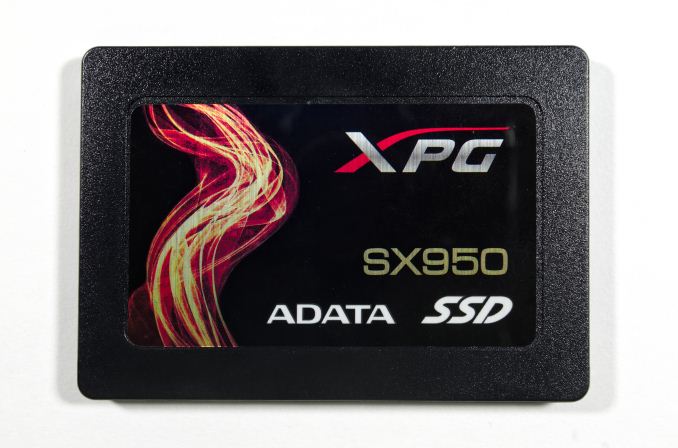The ADATA XPG SX950 480GB SSD Review: In Search of Premium
by Billy Tallis on October 9, 2017 8:00 AM ESTConclusion
At no point in our testing did the ADATA XPG SX950 convince us that it deserves to be regarded as a high-end SATA SSD, nor did it provide any evidence that the high-end SATA segment is still relevant. Under the right conditions, the SX950 can perform as fast as any other SATA SSD, but those are all the same tests where a low-end SATA SSD also performs fine.
Without the performance headroom that PCIe SSDs enjoy, a premium SATA SSD needs to distinguish itself by offering great performance in all conditions, under light or heavy workloads. The SX950 does the opposite. The aggressive SLC caching it uses to deliver high peak performance is a double-edged sword. When subjected to a large volume of writes, the SX950 accrues a large debt of cache flushing and garbage collection that have been deferred. Once the SLC cache fills up, the SX950's performance tanks. Both reads and writes suffer, though write performance much moreso. Worse, it takes the SX950 too long to finish cleaning up even when given the opportunity. The five minutes of idle time our test protocol reserves after filling the drive in preparation for some of the ATSB tests is clearly not long enough, and even during the ATSB Light test the SX950 can't finish catching up on its garbage collection.
The more recent Crucial BX300 uses the same Micron 32L 3D MLC and the same Silicon Motion SM2258 controller, but exhibits a completely different performance profile. Micron learned their lesson about taking SLC caching unnecessarily far on MLC drives with the Crucial MX200, and the BX300 has fairly small fixed-size SLC caches. This leads it to have lower performance than the SX950 under favorable conditions, but the BX300 holds up well under pressure.
The ADATA SX950 offers twice the warranty period of a typical budget SSD and a fairly high write endurance rating, but those are the only ways in which it can be regarded as a premium product. It doesn't even provide TCG Opal encryption support, a distinguishing feature that only a handful of SSD vendors implement for retail SSDs. Micron's first-generation 3D NAND is simply too slow to compete against Samsung's 3D NAND, and the SM2258 is a low-cost/low-power SSD controller that is ill-suited for competing against Marvell and Samsung controllers on performance. The result is a drive that not only falls far short of its lofty performance goals, but a drive that has unbalanced performance and makes poor use of the resources it has at hand.
| SATA SSD Price Comparison | |||
| 240-275GB | 480-525GB | 960-1050GB | |
| ADATA XPG SX950 | $135.22 (56¢/GB) | $269.99 (50¢/GB) | |
| ADATA SU800 | $89.99 (35¢/GB) | $158.65 (31¢/GB) | $274.99 (27¢/GB) |
| Crucial BX300 | $89.99 (38¢/GB) | $149.99 (31¢/GB) | |
| Crucial MX300 | $92.99 (34¢/GB) | $149.99 (29¢/GB) | $279.99 (27¢/GB) |
| Intel SSD 545s | $99.99 (39¢/GB) | $179.99 (35¢/GB) | |
| Samsung 850 PRO | $128.98 (50¢/GB) | $223.32 (44¢/GB) | $447.87 (44¢/GB) |
| Samsung 850 EVO | $99.95 (40¢/GB) | $159.99 (32¢/GB) | $327.99 (33¢/GB) |
| SanDisk Ultra 3D | $99.99 (40¢/GB) | $164.99 (33¢/GB) | $284.99 (29¢/GB) |
| WD Blue 3D NAND | $98.39 (38¢/GB) | $164.65 (33¢/GB) | $299.99 (30¢/GB) |
On a budget SSD, the problems with the ADATA XPG SX950 would be mildly disappointing but reasonable. For light desktop use, the SX950's weaknesses wouldn't come into play. But given the premium pricing, the SX950's failings are unacceptable. ADATA can't beat Samsung's 850 PRO on price, let alone the Crucial BX300.
As the Crucial BX300 shows, most of this could be fixed with radically different firmware. But ADATA can't get anywhere by trying to compete directly against the BX300 and its unbelievably low pricing. Instead, ADATA should take the lessons learned from the SX950 and prepare to offer a more sensible drive when they can get their hands on Micron's second generation 3D NAND, which the Intel 545s suggests will be far faster and more able to match the Samsung 850 PRO, especially if used with Silicon Motion's newest SM2259 SATA controller. However, that would still leave ADATA competing in a very narrow segment of the SSD market, as almost all premium products are now using NVMe and focusing more on performance than endurance and warranty period.











45 Comments
View All Comments
CheapSushi - Tuesday, October 10, 2017 - link
Next year with QLC it'll change. SATAIII is will still be useful for bulk drive SSDs coming. Yeah sure, if you're JUST a gamer and want only ONE drive for everything, it's a no-brainer on what direction to go. If you want just TWO drives, similar. But if you have more than that basic setup, SATAIII QLC SSDs are going to be perfect for bulk storage, while you have your OS and other main programs/software on an NVMe drive(s).MrSpadge - Monday, October 9, 2017 - link
Billy, you need to be less honest with your titles if you want people to actually read your review ;)RaistlinZ - Monday, October 9, 2017 - link
"In Search of Adequate"Lolimaster - Tuesday, October 10, 2017 - link
Years later and still nothing can compete with the 850 EVO 500GBmapesdhs - Wednesday, October 11, 2017 - link
This is how the exchange should go down when storage techs come up with a new SSD design and want approval to proceed:Tech: "We've designed a new SSD!"
Manager: "Is it better than the 850 EVO?"
Tech: "Umm, no."
Manager: "Go away."